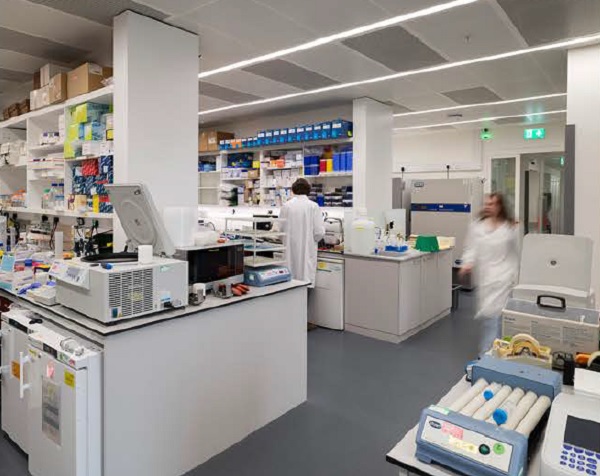The Medical Research Council’s new home for its London Institute of Medical Sciences (LMS) has reached practical completion.
Credited with many life-changing discoveries, the new 12,500sq m building will accommodate over 40 research groups for the first time in a single ultra-modern space to enhance collaboration and research.
In collaboration with Imperial College, and located at its Hammersmith Hospital campus in White City, the project involved engaging with multiple stakeholders with complex technical requirements on a congested hospital site.
The Buro Happold team of laboratory designers and engineers was critical in the successful delivery of this new research building, which will have its official opening in early 2023.
Richard Walder, director at Buro Happold, said: “The new LMS building will be an inspirational environment.
The LMS building carefully weaves together highly-controlled laboratory environments with write-up neighbourhoods that have a warmer, homely feel to support researchers’ sense of wellbeing
“Delivering on the engineering challenges over a wide-ranging scientific brief is testament to the collaborative approach between the client, design, and construction teams.
“It will bring huge benefits to the UK research community for many years to come.”
Working closely with architects Hawkins\Brown, the building incorporates the scientists’ specific needs into world-class technical facilities and workspace, including super-resolution imaging and cryogenic electron microscopy (cryoEM) suites, a data centre, and specialist support facilities.
Breakout spaces have been provided throughout the building to encourage collaboration
Encouraging collaboration
Carol Lees, partner at Hawkins\Brown, said: “The LMS building carefully weaves together highly-controlled laboratory environments with write-up neighbourhoods that have a warmer, homely feel to support researchers’ sense of wellbeing.
“We placed a heavy emphasis on breakout areas, circulation spaces, and cafés to encourage chance encounters and collaboration.”
The science is supported with public engagement spaces and social facilities, all constructed around a visually-impressive feature staircase that runs the full height of the building in a single sweep from the atrium.
This is an outstanding building where high-performance laboratory facilities sit alongside non-lab environments to create collaborative research neighbourhoods supporting their own specialisms and the entire institute
Design and engineering solutions encouraged the sharing of specialist technical equipment and activities by placing them between open flexible laboratories and write-up spaces.
This allowed access to the specialist labs from either end, saving space, costs ,and encouraging greater collaboration between scientists.
Bruce Nepp, director of Buro Happold Laboratory Consultancy, said: “Buro Happold and Hawkins\Brown worked together to develop a complex series of technical briefs into an outstanding building where high-performance laboratory facilities sit alongside non-lab environments to create collaborative research neighbourhoods supporting their own specialisms and the entire institute.”
With the super-resolution imaging and cryoEM suites, the acoustics team needed to mitigate vibration and electro-magnetic fields to exceptionally-low levels, including those generated by moving building lifts and external vehicle movements.
This also included 20% heavier foundations in these locations, as well as careful consideration of the location of plant and logistical facilities.
High-performance laboratory facilities sit alongside non-lab environments to create collaborative research neighbourhoods
Changing working practices
The location of the building on a fully-operational hospital campus also created its own challenges.
Its footprint and access were restricted, requiring a tall building. And the construction activities could not compromise the functioning of the hospital, including the blue-light routes.
“Our research is built upon effective collaboration and the design of our new building has already changed the way we work. We are better connected with one another”, said Jamie Meredith, head of operations at the Medical Research Council, London Institute of Medical Sciences.
Buro Happold also adopted a strategy of reducing energy consumption through efficient design and energy recovery; challenging traditional standards while putting user safety at the forefront.
This was achieved through a series of measures, including optimising air change rates and a focus on HVAC plant efficiency by connecting to the sitewide district heat network which is in the process of being decarbonised.
A photovoltaic array (PV) was also added to the roof, along with interventions for rainwater attenuation, and sedum has been added for biodiversity.
All these measures will allow the facility to benefit from lower running costs so more money can be dedicated to scientific work.
A feature staircase runs the full height of the building in a single sweep




